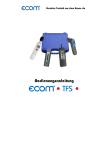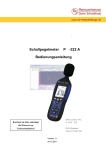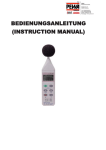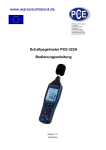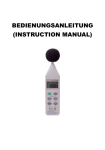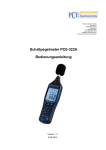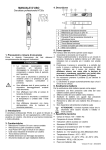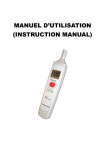Download TFA 31.2001
Transcript
BEDIENUNGSANLEITUNG (INSTRUCTION MANUAL) DATA LOGGER SOUND LEVEL METER INHALTSVERZEICHNIS Titel Seite I. SICHERHEITSINFORMATIONEN 2 II. ALLGEMEINE BESCHREIBUNG 2 III. FEATURES 3 IV. SPEZIFIKATION 3 V. FUNKTIONEN 4 VI. MESSVORBEREITUNG 6 VII. GERÄTEVORBEREITUNG 7 VIII. KALIBRIERUNG 7 IX. 8 MESSUNG 1 DATA LOGGER SOUND LEVEL METER I. SICHERHEITSINFORMATIONEN Lesen Sie bitte sorgsam die folgenden Informationen, bevor Sie mit den Messungen beginnen. Benutzen Sie das Messgerät nur in der beschriebenen Form, anderenfalls erlischt die auf das Gerät gewährleistete Garantie. Umweltbedingungen § Bis 2000m über NN § Relative Feuchtigkeit max. = 90% rH § Arbeitstemperaturbereich = 0 … + 40 °C. Wartung & Reinigung § Reparaturarbeiten am Gerät sollten nur durch den Hersteller durchgeführt werden. § Halten Sie bitte as Gerät sauber und in trockenem Zustand. Sicherheitssymbole Stimmt mit EMC überein Benutzen Sie bei der Wartung nur spezifische Ersatzteile. II. ALLGEMEINE BESCHREIBUNG Vielen Dank, dass Sie sich für dieses Gerät entschieden haben. Um das Gerät bestmöglich zu nutzen, empfehlen wir Ihnen die folgende Betriebsanleitung sorgfältig zu lesen. Das Gerät unterliegt den allgemein gültigen Normen und Standards (IEC61672-1 Klasse2, ANSI S1.4 Typ2) und ist CE-zertifiziert. Dieses Schallpegel-Messinstrument wurde für die Anforderungen für Sicherheitsingenieure, Gesundheit, industrielle Sicherheitsbüros und für Soundqualitätskontrollen in verschiedenen Umgebungen. 2 DATA LOGGER SOUND LEVEL METER III. FEATURES - Handlich - Leichte Bedienung - Preiswert aber Leistungsfähig - Bereichsautomatik - Höchste Aufnahmefähigkeit - 4-stelliges digitales LCD mit einer Auflösung von 0.1 dB - Betriebsinterne Eicheinrichtung IV. SPEZIFIKATION Standards: Frequenzbereich: Messbereich: Mikrophon: Display Auflösung: Werteerneuerung: Frequenzgewichtung: Zeitbewertung: Genauigkeit: Stromversorgung: Batterielebenszeit: IEC61672-1 Klasse2, ANSI S1.4 Typ2 31.5Hz ~ 8KHz 32 ~ 130dB 1/2 inch Electret Kondensor Mikrophon LCD 0.1dB 0.5 s A SCHNELL ±1.4dB ( unter Referenzbedingungen @ 94 dB, 1kHz ) “OVER” wird angezeigt, wenn der aktuelle Messwert höher als der gewählte Messbereich ist “UNDER” wird angezeigt, wenn der aktuelle Messwert niedriger als der gewählte Messbereich ist Zwei IEC R03 (size „AAA“) Batterien, 1,5V X2. ca. 50h (Alkaline Batterie LR03) Arbeitstemperatur: 0 ...+40 °C ( 32 ... +104 °F ) Arbeitsfeuchte: Lagertemperatur: 10 bis 90% rH -10 ... 60 °C ( 14 ... 140 °F ) Alarmfunktionen: 3 DATA LOGGER SOUND LEVEL METER Lagerfeuchte: Abmessung: 10 bis 75%rH 206 (L) × 42 (W) × 25 (H)mm 8.1° (L) x 1.7“ (W) x 1.0“ (H) 100g (0.22 lbs) (inkl. Batterie) Zwei 1,5V Batterie, Bedienungsanleitung, Schraubenzieher. Windschutz. Gewicht: Zubehör: V. FUNKTIONEN 1 4 1.5V X 2 2 SIZE AAA / IEC LR03 Max Hold 3 Press 2 Sec 6 32 dB CAL 130 dB OPEN 7 4 5 DATA LOGGER SOUND LEVEL METER (1) Windschutz Wenn Sie bei Windgeschwindigkeit > 10m/s messen, verwenden Sie bitte den Windschutz auf dem Mikrofon (2) Display Max Mode Indicator Low Battery Indicator Frequency Weighting Indicator Sound Level Reading F Under-Range Indicator Over-Range Indicator Fast Time Weighting Indicator (3) An-/Ausschalter & Max. Haltetaste Anschalter Sie schalten das Gerät ein, indem Sie die „Max Hold“-Taste drücken. Max. Aufnahmemodus Drücken Sie die „Max Hold“-Taste um zum max. Haltemodus zu gelangen. Der LCD wird das „MAX“-Symbol anzeigen. Der Max. Aufnahmemodus beinhaltet und sichert die maximalen Eingabewerte. Wenn das Gerät eine Eingabe entdeckt, die über dem aufgenommenen Maximum ist, speichert das Messgerät den neuen Maximalwert. Mit der „Max Hold“-Taste verlassen Sie den Maximalmodus wieder. Die aufgenommenen Werte werden gelöscht und das „MAX“-Symbol verschwindet. Ausschalter Sie schalten das Gerät aus, indem Sie die „Max Hold“-Taste für mindestens 2 Sekunden gedrückt halten. Der LCD wird „OFF“ anzeigen, danach können Sie die Taste loslassen. 5 DATA LOGGER SOUND LEVEL METER (4) Mikrofon 1/2 inch Electret Kondensor Mikrofon (5) Messung / Kalkulation Messungen oder interne Kalibrierung wählen Schalter aus (6) Kalibrierungsabgleichung (7) Batteriefachdeckel VI. MESSVORBEREITUNG (1) Batterie einfügen Drücken Sie leicht den Batteriefachdeckel und schieben Sie ihn nach unten. Legen Sie zwei 1,5V Batterien ein. Achten Sie dabei auf die Polarität wie sie im Fach angezeigt wird. Schließen Sie den Deckel. (2) Batterieaustausch Wenn die zur Messung benötigte Spannung abfällt, erhalten Sie ein Warnzeichen. Es ist die Batterie (1.5 Volt) zu tauschen. VII. GERÄTEVORBEREITUNG (1) Wehender Wind, welcher übers Mikrofon bläst, wird für zusätzliche Geräusche sorgen. Wenn Sie das Gerät in Gegenwart von Wind benutzen, ist es Pflicht den Windschutz zu befestigen, um keine unerwünschten Geräusche zu empfangen. (2) Kalibrieren Sie das Gerät vor dem Gebrauch, wenn das Gerät längere Zeit nicht mehr benutzt wurde oder in einer schädlichen Umgebung benutzt wurde. (3) Lagern oder benutzen Sie das Gerät nicht bei hohen Temperaturen und hoher Umgebungsfeuchtigkeit. (4) Halten sie das Gerät trocken und vermeiden sie starke Erschütterungen. 6 DATA LOGGER SOUND LEVEL METER (5) Wenn das Messinstrument für eine längere Zeit nicht benutzt wird, sollten die Batterien aus dem Batteriefach nehmen, da diese eventuell auslaufen. VIII . KALIBRIERUNG Das Gerät muss kalibriert sein, bevor Sie eine Messung beginnen. Es gibt zwei verschiedene Arten der Kalibrierung: interne elektrische Kalibrierung und akustische Kalibrierung mit einem Soundkalibrator. Normalerweise wird nur eine interne elektrische Kalibrierung benötigt. Interne Kalibrierung (9dB @ 1kHz) Drücken Sie leicht den Batteriefachdeckel und schieben Sie ihn nach unten. Prüfen Sie, ob der „Cal Mode“ auf „Internal CAL“ gesetzt wurde. Das LCD wird für etwa 1 Sekunde „CAL“ anzeigen. Aktivieren Sie den eingebauten Oszillator ( 1 kHz, Sinuskurve) für die elektrische Kalibrierung des Geräts. Am Ende der Kalibrierung schieben sie den Schalter auf die „MEAS“ position. IX. MESSUNG (1) Schalten Sie das Gerät ein und wählen Sie die von Ihnen gewünschten Parameter und Einstellungen aus. Standardmäßig wird die A-Bewertung verwendet, um dem menschlichen Hörempfinden nahe zu kommen. (2) Stellen Sie sicher, dass der Schalter an der Rückseite des Geräts auf „MEAS“ steht. (3) Halten Sie das Messgerät in Richtung der Schallquelle (4) Die numerische Ebenenanzeige zeigt den momentan gemessenen Geräuschpegel. Der Messwert wird jede Sekunde zwei Mal aktualisiert. 7 DATA LOGGER SOUND LEVEL METER CONTENTS Title Page I. SAFETY INFORMATION 10 II. GENERAL DESCRIPTION 10 III. FEATURES 11 IV. SPECIFICATIONS 11 V. NAME AND FUNCTIONS 12 VI. MEASUREMENT PREPARATION 14 VII. OPERATING PRECAUTIONS 14 VIII. CALIBRATION 15 IX. 15 MEASUREMENT 8 DATA LOGGER SOUND LEVEL METER I. SAFETY INFORMATION Read the following safety information carefully before attempting to operate or service the meter. Use the meter only as specified in this manual; otherwise, the protection provided by the meter may be impaired. Environment conditions § Altitude up to 2000 meters § Relatively humidity 90% max. § Operation Ambient 0 ~ 40°C Maintenance & Clearing § Repairs or servicing not covered in this manual should only be performed by qualified personnel. § Periodically wipe the case with a dry cloth. Do not use abrasives or solvents on this instruments. Safety symbols Comply with EMC When servicing, use only specified replacement parts. II. GENERAL DESCRIPTION Thank you for using our Sound Level Meter. To ensure that you can get the most from it, we recommend that you read and follow the manual carefully before use. This unit conforms to the IEC61672-1 Class2, ANSI S1.4 Type2 for Sound Level Meters. This Sound Level Meter has been designed to meet the measurement requirements of safety Engineers, Health, Industrial safety offices and sound quality control in various environments. 9 DATA LOGGER SOUND LEVEL METER III. FEATURES § Mini size § Easy to use § High performance at a low cost § Autoranging § Maximum recording § 4-digit LCD with a resolution of 0.1 dB § Internal Calibrator (94dB@1kHz) IV. SPECIFICATIONS Standard applied: Frequency range: Measuring level range: Microphone: Display: Resolution: Display Update: Frequency Weighting: Time Weighting: Accuracy: IEC61672-1 Class2, ANSI S1.4 Type2 31.5Hz ~ 8KHz 32 ~ 130dB 1/2 inch electret condenser microphone LCD 0.1dB 0.5 sec. A FAST ±1.4dB ( under reference conditions, 94dB @ 1kHz ) Alarm function: “OVER” when input is more than upper limit of range. “UNDER” when input is Less than lower limit of range. Power supply: Two IEC R03 (size “AAA”) batteries, 1.5V X2. Battery Life: Approx. 50hrs (alkaline battery LR03) Operation temperature: 0 to 40°C ( 32 to 104°F ) Operation humidity: 10 to 90%RH Storage temperature: -10 to 60°C ( 14 to 140°F ) Storage humidity: 10 to 75%RH Dimensions: 206 (L) × 42 (W) × 25 (H)mm 10 DATA LOGGER SOUND LEVEL METER 8.1” (L) × 1.7” (W) × 1.0” (H) 100g (0.22 lbs) (including batteries) two 1,5V batteries, instruction manual, screwdriver, windscreen. Weight: Accessories: V. NAME AND FUNCTIONS 1 4 1.5V X 2 2 SIZE AAA / IEC LR03 Max Hold 3 Press 2 Sec 6 32 dB CAL 5 130 dB OPEN 7 (1) Windscreen When making outdoor measurements in windy weather, wind noise at he microphone can cause measurement errors. Such effects can be using the windscreen. 11 DATA LOGGER SOUND LEVEL METER (2) Display Max Mode Indicator Low Battery Indicator Frequency Weighting Indicator Sound Level Reading F Under-Range Indicator (3) Over-Range Indicator Fast Time Weighting Indicator Power On/Off & Max Hold button Power On Turn the unit on by press the “Max Hold” button. Max recording mode Press the “Max Hold” button to enter the Max Hold mode under the power-on. The LCD will show “MAX” symbol.The MAX recording mode captures and stores the maximum input values detected. When the unit detects an input that is above the recorded maximum, the unit recods the new maximum value. Press the “Max Hold” button again to exit the MAX mode. Recorded values are erased, “MAX” symbol disappears. Power-off Turn the unit off by holding down the “Max Hold” button for at least 2 seconds. The LCD will show “OFF”, release the button. (4) Microphone 1/2 inch electret Condenser microphone (5) Measurement / Calculation Measurements or internal calibrator select switch (6) Calibration adjustment (7) Battery Cover 12 DATA LOGGER SOUND LEVEL METER VI. MEASUREMENT PREPARATION (1) Inserting the batteries Lightly press the battery cover and slide it to the down. Insert two 1.5V batteries, paying attention to the polarity as indicated in the compartment. Replace the cover. (2) Battery Replacement When the battery voltage drops below the operating voltage, this symbol will appear. Replace 1.5 Volt batteries. VII. OPERATION PRECAUTIONS (1) (2) (3) (4) (5) Wind blowing across the microphone will bring additional extraneous noise. When using the instrument in the presence of wind, it is a must to mount the windscreen to not pick up undesired signals. Calibrate the instrument before the operation if the instrument was not in use for a long time or operated in bad environment. Do not store or operate the instrument at high temperature and high humidity environment. Keep microphone dry and avoid severe vibration. If the unit is not used for a long period of time, the batteries will have to be removed from the battery compartment, since it might leak. VIII. CALIBRATION Before starting a measurement, the unit must be calibrated. There are two types of calibration: internal electrical calibration and acoustic calibration using a sound calibrator. Normally, internal electrical calibration only is required. Internal Calibrator (9dB @ 1kHz) Lightly press the battery cover and slide it to the down. Slide the switch to the down. Verify that the Cal Mode is set to “Internal” CAL. LCD shows “CAL” approx. 1 sec. Activates the built-in oscillator (1 kHz, sine wave) for electrical calibration of the unit. When calibration is end, slide the switch to the up “MEAS” position. 13 DATA LOGGER SOUND LEVEL METER IX . MEASUREMENT (1) (2) (3) (4) Turn the power ON to measure noise sound. For general sound level measurements, A- - frequency weighting and F (FAST) time weighting (dynamic characteristics) the setting should be used. Make sure that slide the switch to the “MEAS” position on rear of the unit. Hold the instrument comfortably in hand and point the microphone at the suspected noise source. The numeric level indication shows the current measured sound level. The reading is updated twice every second. 14
This document in other languages
- Deutsch: TFA 31.2001















